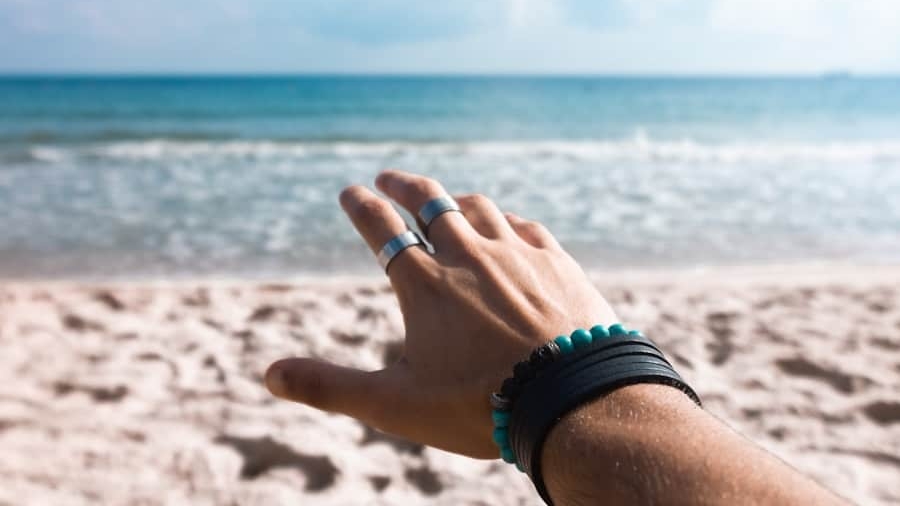In recent years, the increasing awareness of skin cancer and the harmful effects of ultraviolet (UV) radiation has led to a surge in the development and adoption of wearable UV monitors. These devices, which can be worn on the skin or as accessories, are designed to measure UV exposure in real-time, providing users with valuable information about their sun exposure levels. The rise of these monitors can be attributed to several factors, including advancements in technology, a growing public health campaign focused on skin cancer prevention, and an increasing number of individuals seeking to take proactive measures in managing their health.
The proliferation of smartphones and wearable technology has made it easier than ever for consumers to access health-related information. Wearable UV monitors often integrate with mobile applications, allowing users to track their UV exposure alongside other health metrics. This integration not only enhances user engagement but also fosters a more comprehensive understanding of personal health.
As skin cancer rates continue to climb globally, the demand for effective monitoring solutions has never been more pressing. Consequently, the market for wearable UV monitors is expanding rapidly, with various companies introducing innovative products that cater to different demographics and lifestyles.
Key Takeaways
- Wearable UV monitors are becoming increasingly popular as a tool for tracking sun exposure and preventing skin damage.
- These monitors typically use sensors to measure UV radiation and provide real-time feedback on sun exposure levels.
- UV monitoring is crucial in preventing skin cancer, as excessive UV exposure is a major risk factor for the disease.
- Wearable UV monitors have the potential to improve public health by raising awareness about sun safety and reducing the incidence of skin cancer.
- While wearable UV monitors offer benefits such as real-time monitoring, they also have limitations, such as accuracy and user compliance.
How wearable UV monitors work
Wearable UV monitors operate using a combination of sensors and algorithms that detect and quantify UV radiation exposure. Most devices utilize photodiodes or phototransistors that are sensitive to UV light, allowing them to measure the intensity of UV radiation in real-time. When exposed to sunlight, these sensors convert UV light into electrical signals, which are then processed by the device’s internal software.
This data is typically displayed on a screen or transmitted to a connected smartphone app, where users can view their cumulative UV exposure over time. The sophistication of these devices varies widely. Some basic models provide simple alerts when UV levels reach a certain threshold, while more advanced monitors can offer personalized recommendations based on skin type, location, and time of day.
For instance, certain devices may use GPS data to assess local UV index levels and adjust their alerts accordingly. Additionally, many wearable UV monitors are designed to be waterproof and durable, making them suitable for outdoor activities such as swimming or hiking. This versatility ensures that users can rely on these devices in various environments without compromising their functionality.
The importance of UV monitoring in skin cancer prevention
Monitoring UV exposure is crucial in the fight against skin cancer, which is one of the most common forms of cancer worldwide. The World Health Organization (WHO) estimates that over 3 million non-melanoma skin cancers and 132,000 melanoma skin cancers occur globally each year. Prolonged exposure to UV radiation is a significant risk factor for developing these conditions, as it can damage the DNA in skin cells and lead to mutations that result in cancer.
By utilizing wearable UV monitors, individuals can gain insights into their sun exposure habits and make informed decisions about sun safety. The importance of UV monitoring extends beyond individual health; it also plays a vital role in public health initiatives aimed at reducing skin cancer rates. By raising awareness about the dangers of excessive sun exposure and promoting proactive measures such as regular skin checks and protective clothing, public health campaigns can leverage data from wearable UV monitors to tailor their messaging effectively.
For example, if a community shows high levels of UV exposure during specific times of the year, targeted educational efforts can be implemented to encourage sun safety practices during those periods.
The potential impact of wearable UV monitors on public health
The integration of wearable UV monitors into daily life has the potential to significantly impact public health outcomes related to skin cancer prevention. By providing individuals with real-time feedback on their UV exposure, these devices empower users to take control of their sun safety practices. This empowerment can lead to behavioral changes that reduce the risk of skin cancer, such as seeking shade during peak sunlight hours, wearing protective clothing, and applying sunscreen more consistently.
Moreover, the data collected from wearable UV monitors can contribute to broader epidemiological studies aimed at understanding patterns of UV exposure within populations. Public health officials can analyze this data to identify trends and risk factors associated with skin cancer incidence in specific demographics or geographic areas. This information can inform policy decisions regarding sun safety regulations, such as implementing stricter guidelines for outdoor activities during high UV index days or promoting educational campaigns in regions with high rates of skin cancer.
Advantages and limitations of wearable UV monitors
Wearable UV monitors offer several advantages that make them appealing for individuals concerned about sun safety. One significant benefit is their convenience; these devices are typically lightweight and easy to wear, allowing users to monitor their UV exposure without disrupting their daily routines. Additionally, many models feature user-friendly interfaces that provide instant feedback on exposure levels, making it simple for individuals to understand when they need to take protective measures.
However, there are limitations associated with wearable UV monitors that must be considered. One primary concern is accuracy; while many devices are designed to provide reliable readings, factors such as sensor calibration and environmental conditions can affect performance. For instance, a monitor may not account for reflections from surfaces like water or sand that can increase UV exposure.
Furthermore, some users may become overly reliant on these devices, neglecting other essential sun safety practices such as regular sunscreen application or seeking shade.
The role of wearable UV monitors in promoting sun safety
Wearable UV monitors play a pivotal role in promoting sun safety by fostering a culture of awareness and responsibility regarding UV exposure. By providing real-time data on sun exposure levels, these devices encourage users to adopt healthier behaviors when spending time outdoors.
In addition to individual behavior change, wearable UV monitors can also facilitate social interactions around sun safety. Users may share their experiences and insights with friends and family, creating a community-focused approach to sun protection. This social aspect can amplify the impact of wearable technology on public health by encouraging collective action toward reducing skin cancer risk within communities.
The future of wearable UV monitors in skin cancer prevention
As technology continues to advance, the future of wearable UV monitors looks promising in terms of enhancing their effectiveness in skin cancer prevention. Innovations such as improved sensor technology and artificial intelligence could lead to more accurate readings and personalized recommendations based on individual risk factors. For instance, future devices may incorporate machine learning algorithms that analyze user behavior patterns over time and provide tailored advice on sun safety practices.
Moreover, the integration of wearable UV monitors with other health tracking technologies could create a more holistic approach to personal health management. For example, combining data from wearable fitness trackers with UV exposure information could help users understand how physical activity levels correlate with sun exposure risks. This comprehensive view could empower individuals to make informed decisions about their overall health while prioritizing sun safety.
Recommendations for using wearable UV monitors effectively
To maximize the benefits of wearable UV monitors in promoting sun safety and preventing skin cancer, users should follow several best practices. First and foremost, it is essential to choose a device that suits individual needs and lifestyle preferences.
Once equipped with a wearable UV monitor, users should familiarize themselves with its features and functionalities. Understanding how the device measures UV exposure and what thresholds trigger alerts will enable individuals to respond appropriately when they receive notifications about high levels of radiation. Additionally, users should integrate the insights gained from their monitors into their daily routines by consistently applying sunscreen, wearing protective clothing, and seeking shade during peak sunlight hours.
Regularly reviewing cumulative exposure data can also help users identify patterns in their sun habits and make necessary adjustments over time. By maintaining an active engagement with their wearable UV monitor, individuals can cultivate a proactive approach to sun safety that significantly reduces their risk of developing skin cancer while enjoying outdoor activities responsibly.
A related article to The Impact of Wearable UV Monitors on Skin Cancer Prevention is “Stay Stylish with Wear OS by Google” which discusses the latest trends in wearable technology and how they can be integrated into everyday fashion. This article provides insights into how wearable devices like smartwatches can not only track UV exposure but also complement one’s personal style. To learn more about staying fashionable while utilizing wearable technology, check out this article.
FAQs
What are wearable UV monitors?
Wearable UV monitors are devices that can be worn on the body to track and measure exposure to ultraviolet (UV) radiation from the sun. These devices can provide real-time data on UV exposure levels and can alert the wearer when they are at risk of sunburn.
How do wearable UV monitors help prevent skin cancer?
Wearable UV monitors help prevent skin cancer by providing users with information about their UV exposure levels. By alerting users when they are at risk of sunburn, these devices can help individuals take proactive measures to protect their skin, such as seeking shade, applying sunscreen, or wearing protective clothing.
Are wearable UV monitors effective in preventing skin cancer?
While wearable UV monitors can be a helpful tool in raising awareness about UV exposure and encouraging sun-safe behaviors, they are not a foolproof method for preventing skin cancer. It is important for individuals to use multiple strategies for sun protection, including seeking shade, wearing protective clothing, and using sunscreen in addition to using a UV monitor.
What are the potential benefits of using wearable UV monitors?
Some potential benefits of using wearable UV monitors include increased awareness of UV exposure levels, personalized sun safety recommendations, and the ability to track UV exposure over time. These devices can also be particularly useful for individuals with a higher risk of skin cancer, such as those with fair skin or a history of sunburns.
Are there any limitations to using wearable UV monitors?
Limitations of wearable UV monitors may include accuracy of UV measurements, reliance on user compliance, and the need for regular calibration and maintenance. Additionally, these devices may not account for other factors that contribute to skin cancer risk, such as genetic predisposition or environmental factors.



